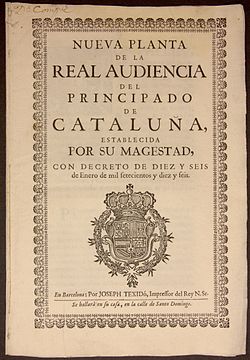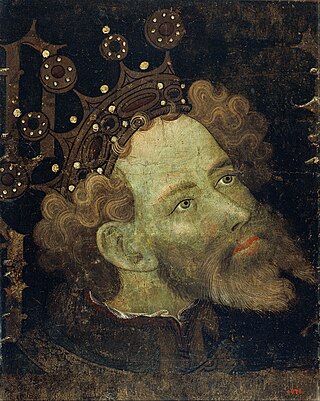
Peter IV, called the Ceremonious, was from 1336 until his death the king of Aragon, Sardinia-Corsica, and Valencia, and count of Barcelona. In 1344, he deposed James III of Majorca and made himself King of Majorca.

The Kingdom of Majorca was a realm on the east coast of Spain, which included certain Mediterranean islands, and which was founded by James I of Aragon, also known as James the Conqueror. In a will written in 1262 after the death of his firstborn son Alfonso, he ceded the kingdom to his son James. The disposition was maintained during successive versions of his will and so when James I died in 1276, the Crown of Aragon passed to his eldest son Peter, known as Peter III of Aragon or Peter the Great. The Kingdom of Majorca passed to James, who reigned under the name of James II of Majorca. After 1279, Peter III of Aragon established that the King of Majorca was a vassal to the king of Aragon. The title continued to be employed by the Aragonese and Spanish monarchs until its dissolution by the 1715 Nueva Planta decrees.

The Kingdom of Aragon was a medieval and early modern kingdom on the Iberian Peninsula, corresponding to the modern-day autonomous community of Aragon, in Spain. It should not be confused with the larger Crown of Aragon, which also included other territories—the Principality of Catalonia, the Kingdom of Valencia, the Kingdom of Majorca, and other possessions that are now part of France, Italy, and Greece—that were also under the rule of the King of Aragon, but were administered separately from the Kingdom of Aragon.

The Kingdom of Navarre, originally the Kingdom of Pamplona, was a Basque kingdom that occupied lands on both sides of the western Pyrenees, with its northernmost areas originally reaching the Atlantic Ocean, between present-day Spain and France.

Fuero, Fur, Foro or Foru is a Spanish legal term and concept. The word comes from Latin forum, an open space used as a market, tribunal and meeting place. The same Latin root is the origin of the French terms for and foire, and the Portuguese terms foro and foral; all of these words have related, but somewhat different meanings.
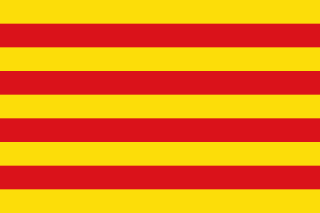
The Crown of Aragon was a composite monarchy ruled by one king, originated by the dynastic union of the Kingdom of Aragon and the County of Barcelona and ended as a consequence of the War of the Spanish Succession. At the height of its power in the 14th and 15th centuries, the Crown of Aragon was a thalassocracy controlling a large portion of present-day eastern Spain, parts of what is now southern France, and a Mediterranean empire which included the Balearic Islands, Sicily, Corsica, Sardinia, Malta, Southern Italy and parts of Greece.

The Kingdom of Valencia, located in the eastern shore of the Iberian Peninsula, was one of the component realms of the Crown of Aragon.

The Principality of Catalonia was a medieval and early modern state in the northeastern Iberian Peninsula. During most of its history it was in dynastic union with the Kingdom of Aragon, constituting together the Crown of Aragon. Between the 13th and the 18th centuries, it was bordered by the Kingdom of Aragon to the west, the Kingdom of Valencia to the south, the Kingdom of France and the feudal lordship of Andorra to the north and by the Mediterranean Sea to the east. The term Principality of Catalonia was official until the 1830s, when the Spanish government implemented the centralized provincial division, but remained in popular and informal contexts. Today, the term Principat (Principality) is used primarily to refer to the autonomous community of Catalonia in Spain, as distinct from the other Catalan Countries, and usually including the historical region of Roussillon in Southern France.
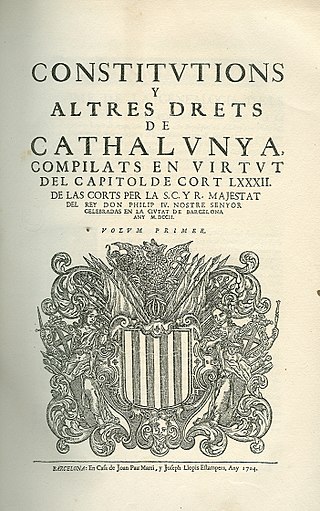
The Catalan constitutions were the laws of the Principality of Catalonia promulgated by the Count of Barcelona and approved by the Catalan Courts. The Corts in Catalan have the same origin as courts in English but instead meaning the legislature. The first constitutions were promulgated by the Corts of 1283. The last ones were promulgated by the Corts of 1705. They had pre-eminence over the other legal rules and could only be revoked by the Catalan Courts themselves. The compilations of the constitutions and other rights of Catalonia followed the Roman tradition of the Codex.

The Crown of Castile was a medieval polity in the Iberian Peninsula that formed in 1230 as a result of the third and definitive union of the crowns and, some decades later, the parliaments of the kingdoms of Castile and León upon the accession of the then Castilian king, Ferdinand III, to the vacant Leonese throne. It continued to exist as a separate entity after the personal union in 1469 of the crowns of Castile and Aragon with the marriage of the Catholic Monarchs up to the promulgation of the Nueva Planta decrees by Philip V in 1715.

Both the perceived nationhood of Spain, and the perceived distinctions between different parts of its territory derive from historical, geographical, linguistic, economic, political, ethnic and social factors.

The military history of Catalonia began in the thirteenth century, with the first exploits of the armies under the orders of Catalan rulers and lasting until today, where Catalan soldiers are integrated into international forces.

Ferdinand II was King of Aragon from 1479 until his death in 1516. As the husband of Queen Isabella I of Castile, he was also King of Castile from 1475 to 1504. He reigned jointly with Isabella over a dynastically unified Spain; together they are known as the Catholic Monarchs. Ferdinand is considered the de facto first king of Spain, and was described as such during his reign, even though, legally, Castile and Aragon remained two separate kingdoms until they were formally united by the Nueva Planta decrees issued between 1707 and 1716.
Corregimiento is a Spanish term used for country subdivisions for royal administrative purposes, ensuring districts were under crown control as opposed to local elites. A corregimiento was usually headed by a corregidor.
The constitution of Spain of 1978 allowed for the nationalities and regions that make up the Spanish nation to accede to self-government and be constituted as autonomous communities, which became the first-order political and territorial division of the Spanish territory. Both the process whereby the nationalities and regions were to accede to self-government and the scope of competences that were to be devolved or transferred from the central government, were intended to be asymmetrical in nature.

The Catalan Courts or General Court of Catalonia were the policymaking and parliamentary body of the Principality of Catalonia from the 13th to the 18th century.

The Polysynodial System, Polysynodial Regime or System of Councils was the way of organization of the composite monarchy ruled by the Catholic Monarchs and the Spanish Habsburgs, which entrusted the central administration in a group of collegiate bodies (councils) already existing or created ex novo. Most of the councils were formed by lawyers trained in academic study of Roman law. After its creation in 1521, the Council of State, chaired by the monarch and formed by the high nobility and clergy, became the supreme body of the monarchy. The polysynodial system met its demise in the early 18th century in the wake of the promulgation of the Nueva Planta decrees by the incoming Bourbon dynasty, which organized a system underpinned by Secretaries of State.

The Spanish institutions of the Ancien Régime were the superstructure that, with some innovations, but above all through the adaptation and transformation of the political, social and economic institutions and practices pre-existing in the different Christian kingdoms of the Iberian Peninsula in the Late Middle Ages, presided over the historical period that broadly coincides with the Modern Age: from the Catholic Monarchs to the Liberal Revolution and which was characterized by the features of the Ancien Régime in Western Europe: a strong monarchy, a estamental society and an economy in transition from feudalism to capitalism.
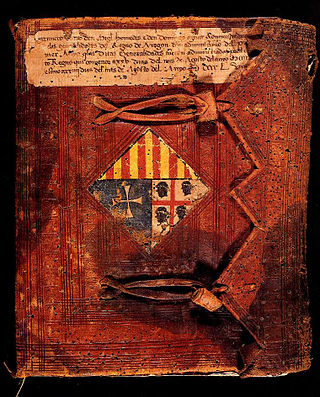
The Diputación del General del Reino de Aragón, Diputación del Reino de Aragón or Generalidad de Aragón was an Aragonese institution in force between 1364 and 1708 whose function was the representation by the estates of the realm of the Kingdom of Aragon in periods between Cortes before the King of Aragon and the rest of the peninsular kingdoms. It was in charge of intervening in internal and external fiscal, administrative and political affairs and of safeguarding and ensuring compliance with the aragonese Fueros.
